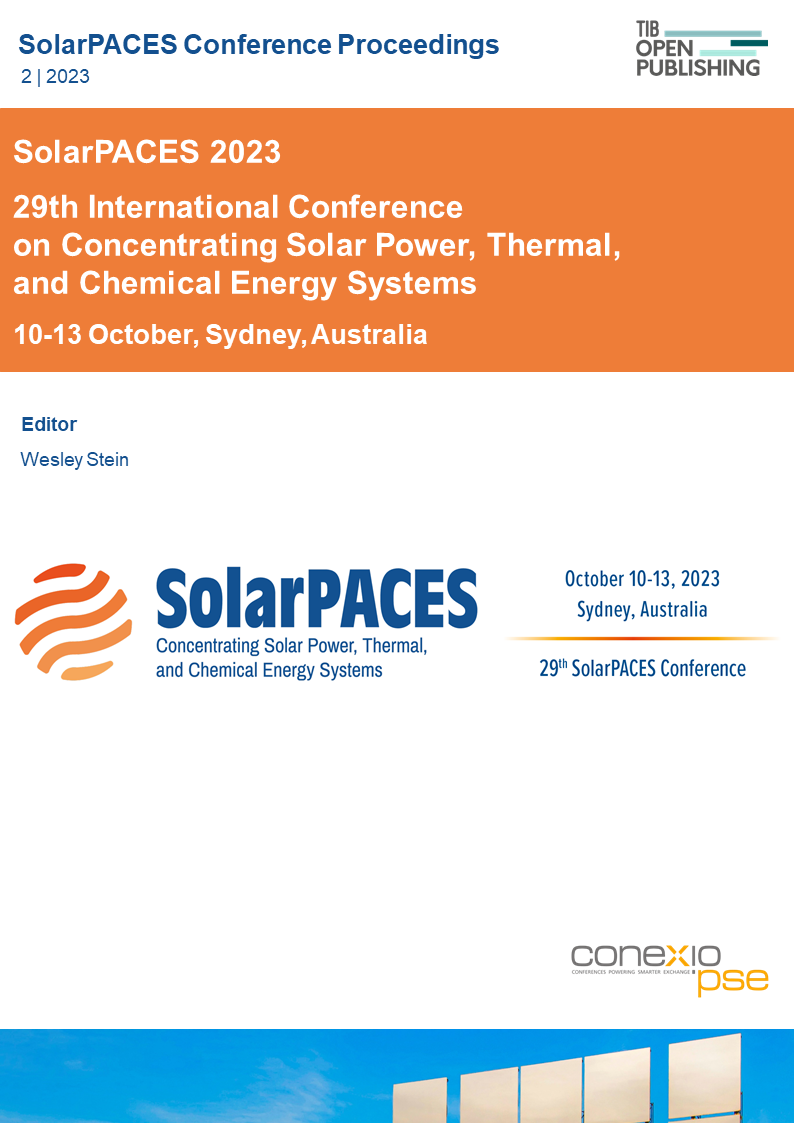Experimental Operation of a Prototype 750C Advanced Chloride Molten Salt Bellows Valve
DOI:
https://doi.org/10.52825/solarpaces.v2i.829Keywords:
Molten Salt, Experimental Valves, Heat PipesAbstract
To achieve DOE 2030 SunShot targets that reduce the cost of liquid-based solar by an additional 40% to 70% beyond 2018 costs, a more reliable, highly manufacturable flow valve, capable of achieving operational temperatures of >700°C is required [1]. This paper investigates the development of an innovative high-temperature chloride molten salt valve, with operation up to 750°C. This valve is intended to be employed within Gen 3 CSP liquid-based thermal energy storage (TES) systems as well as Gen 4 modular salt reactor (MSR) technologies. This work details the general design and flow testing of a bellows-seal flow control valve (FCV). This design includes an integrated closed-loop thermal control system to ensure robust design for freeze-thaw cycles. The self-contained thermal management STM system, is unique in the salt valve industry since it is an integrated solution to provide a consistent, repeatable alternative to typical heat tracing. Additionally, the design includes the employment of a novel heat pipe valve stem to facilitate enhanced passive thermal management into the valve assembly. This valve stem heat pipe is designed to facilitate natural circulation within the bonnet to ensure robust operation, during both nominal and transient thermal operation. The valve body and trim will be designed using SS316H, consistent with Flowserve Corporation’s existing product base and is code qualified but will utilize clad material for materials corrosion, manufacturing cost reduction and compatibility to ensure design flexibility. A test campaign was performed in this investigation utilizing a novel 750°C ternary chloride (20%NaCl/40%MgCl2/40%KCl by mol. wt. %) molten salt flow loop. A discussion about the design and installation of the valves within this test bed is provided for this investigation. Valve test results from this study assessed Cv curves as well as multiple actuator cycles, under varying thermodynamic and operational mode conditions, which would be characteristic within a commercial molten salt facility. The results indicate nominal operation for the baseline design, though improved performance and reliability is expected with the full designed FCV.
Downloads
References
[1] Gauche, P., Shultz, A., Stapp, D., Sullivan, S., Ho, C.K., Turchi, C., Zhu, G., Yellowhair, J. and Mehos, M., 2019, U.S. DOE Gen3 and SunShot 2030 Concentrating Solar Power R&D: In search of $0.05/kWh autonomy and seasonal storage... Sandia National Lab. (SNL-NM), Albuquerque, NM (United States). Proposed for presentation at the Southern African Solar Energy Conference (SASEC); East London, WC, South Africa. https://www.osti.gov/servlets/purl/1643630
[2] Skousen, P.L., 2011. Valve handbook. McGraw-Hill Education.
[3] ASME Section II, Part D, 2013, No Addenda.
[4] Verification of XL Spreadsheet BFLANGE-INT-NUC, Flowserve Verification Report, Rev. 0, August 6, 2012, Flowserve Corporation, Springville, Utah
[5] ASME Section III, 2013, No Addenda
[6] Verification of XL Spreadsheet BFLANGE-NUC, Flowserve Verification Report, Rev. 1, April 29, 2010, Flowserve Corporation, Springville, Utah
[7] Armijo, K.M., Carlson, M.D., Dorsey, D.S., Ortega, J.D., Dimitri D., Christian, J.M. and Turchi, C.S., “Operational Modes of a 2.0 MWth Chloride Molten-Salt Pilot-Scale System” in Proceedings of SolarPACES 2019, Daegu, South Korea, 2019, https://doi.org/10.1063/5.0029218 DOI: https://doi.org/10.1063/5.0029218
Published
How to Cite
Conference Proceedings Volume
Section
License
Copyright (c) 2025 Kenneth Armijo, Aaron Overacker, Ansel Blumenthal, Jeffrey Parish, Michael Nelson, Ivica Radman, Javier Martell

This work is licensed under a Creative Commons Attribution 4.0 International License.
Accepted 2024-11-13
Published 2025-02-03
Funding data
-
National Nuclear Security Administration
Grant numbers DE-NA0003525
